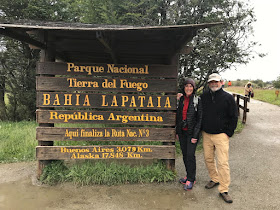This post is long overdue but I took a break after returning from Antarctica in early February. I hope to get back to blogging now as the spring season begins. Thank you for your patience.
For the 29th time, I headed south to Antarctica during the Austral summer. The trip began in Argentina with a short stop in Buenos Aires and then a three-an-a-half hour flight to Ushuaia on South America's largest island., Tierra del Fuego This time I was able to take my wife Helen on the trip - her first time to South America and Antarctica.
Leaving Flagstaff. Little did we know that we would miss the best winter weather in Flagstaff while gone. Still, Antarctica was mostly warmer than Flagstaff.
Leaving Buenos Aires going to Ushuaia. This part of South America was experiencing a very wet summer.
Ushuaia is a unique city of about 70,000 people. It has grown like a weed in the last several decades in response to the growing Antarctic tourism trade. It began as a far-away national prison, much like our Alcatraz.
Wouldn't you know it! We met two friends from Arizona while walking the streets in Ushuaia. They were finishing their Antarctic trip while we were just beginning ours. Small world indeed.
We had a free day and visited the nearby Tierra del Fuego National Park with its beautiful fjords and blue lakes.
The end of the road in the National Park is also the southern end of the Pan-American Highway. Only 11,000 miles to Prudhoe BayAlaska! I'd love to do it one day.
There are signs everywhere in Argentina proclaiming that the Falkland Islands (or Malvinas) belong to them.
The southern beech forest (genus Nothofagus) is one of my favorite environments anywhere. The greens are vibrant, well watered and welcome protection from the incessant winds.
Did I mention the green that is found everywhere here?
The landscape has been carved by glaciers that have receded since the end of the last Ice Age. Views like this are modern analogs for the Antarctic landscape prior to it being subjected to the 'deep freeze' which began about 34 million years ago. Petrified wood in Antarcticas is largely from the genus Nothofagus.
The world's southernmost train is located within the Park. It originally went from the prison in Ushuaia to the area of the Park for the harvesting and collection of firewood by the prisoners. Wr had a wonderful free day in Ushuaia and we sailed at about 7 PM that evening.
After a full day sailing east, we arrived in Stanley, Falkland Islands.
These tiny islands located far south in the South Atlantic Ocean are little piece of Britain in the middle of nowhere.
The Globe Tavern in the background is a place to watch football and get a pint.
Helen and I took a farm visit about 35 miles out in the bush. One of the biggest geological resources here is peat, decayed vegetation that is cut into blocks for heating.
The blocks are thrown up to dry, taking up to six weeks. They are quite wet when first removed, as I found out when I tried to throw one up - it slipped off of the shovel and onto my clean pants. The stain, while indistinct will be on these pants forever.
Inside the farmhouse. The stove is heated with peat.
Of course, we had a sheep shearing demonstration, for which the sheep were quite nervous.
Beautiful, exotic lupines at the farm.
The Falklands are famous for their stone runs, which Charles Darwin noted on his visits in the 1830s. See this abstract here for a description of these features.
The 'whalebone church' in Stanley.
Inside the church. My next post will cover a visit to South Georgia Island.






















No comments:
Post a Comment
If your comment will not post, email me with the problem.